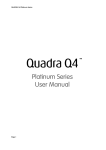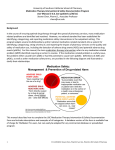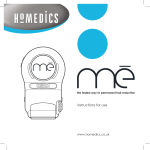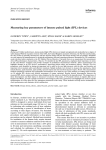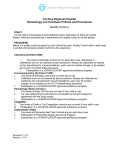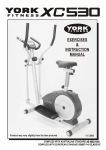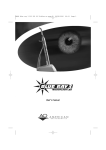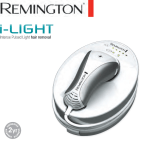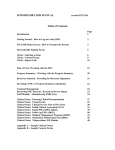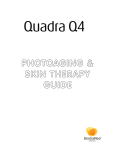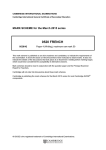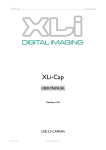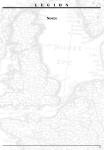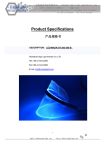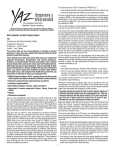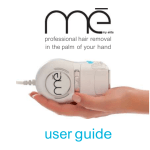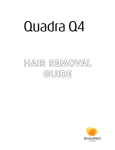Download Section 1: Introduction
Transcript
QUADRA Q4 Diamond Series II ™ DIAMOND SERIES II User Manual Page 1 QUADRA Q4 Diamond Series II QUADRA Q4™ DIAMOND SERIES II INTENSE PULSED LIGHT SYSTEM Page 2 QUADRA Q4 Diamond Series II Table of Contents 1. Safety Warnings 1.1 Optical Safety 1.2 Optical Safety – Label Placement 1.4 Safety Warnings – Electrical Safety 2. Product Description 2.1 List of Controls 2.2 Specification 3. Transport and Installation 3.1 Transport Damage. 3.2 Environmental Transport & Storage Conditions 3.3 Installation 3.4 Space Requirements 3.5 Accessories 4. System Operation 4.1 Switch On Procedure 4.2 Installation of the Disposable Lamp Unit 4.3 Cleaning the Handset Glass Transmission Block 4.3.1 Outside of the Applicator & Quartz Glass Transmission Block 4.3.2 Inside Surface of Quartz Glass Transmission Block 4.4 Start Up 4.5 Disposable Head Expiry 4.6 Program and Energy Selection 4.7 Armed / Standby Mode 4.8 Cooling Periods 4.9 Switch off Procedure 4.10 QUADRA Q4 Diamond Series II Set-up Quick Guide 5. Typical Treatment Protocol 5.1 Indications for Use 5.2 Contraindications 5.3 Treatment Related Problems 5.4 Treatment Protocol – General Considerations 5.5 Post Treatment Care 5.6 QUADRA Q4 DIAMOND SERIES II Treatment Programs 5.7 HAIR REMOVAL - Typical Treatment Procedure 5.8 SKIN REJUVENATON – Typical Treatment Procedure 5.9 INFLAMMATORY ACNE - Typical Treatment 6. General Maintenance 6.1 Cleaning the Equipment 6.2 Visual Inspection 6.3 Servicing 6.4 Removal and Replacement of the Disposable Lamps. 6.5 Servicing and Maintenance Schedule 6.6 Safe Disposal 7. Fault Diagnostics 7.1 Unit Will Not Switch On 7.2 QUADRA Q4 DIAMOND SERIES II Error Messages Page 3 4 5 6 7 9 11 12 13 13 13 13 13 13 14 14 16 20 20 20 21 21 21 23 26 26 27 28 28 28 29 29 30 31 31 32 35 36 36 36 37 37 37 37 38 39 40 QUADRA Q4 Diamond Series II 1. Safety Warnings CAUTION Use of controls or adjustments, or performance of procedures other than those specified herein may result in hazardous optical radiation exposure. No attempt should be made to operate this equipment until the User Manual has been read and fully understood. In addition, a clear understanding of the biological effects of the interaction of light with tissue should be prerequisite to use of this equipment. When not in use, the equipment should be protected from unqualified use by removal of the key from the key-switch. IT IS STRONGLY RECOMMENDED THAT ALL OPERATORS OF THIS EQUIPMENT ATTEND THE SUPPLIERS APPROVED TRAINING COURSE PRIOR TO USE. Page 4 QUADRA Q4 Diamond Series II 1.1 Optical Safety Suitable protective eyewear is required to be used during operation of the system. In addition, it is the responsibility of the User to ensure that the client is supplied with suitable protective eyewear during treatment. The optical hazard warning label (Figure 1) is located on the side of the Quadra Q4 Diamond Series II Unit. Figure 1: Optical Hazard Warning Label Page 5 QUADRA Q4 Diamond Series II 1.2 Optical Safety – Label Placement (Figure 2) shows the placement on the Quadra Q4 Diamond Series II of the warning labels. Figure 2: Warning Label Placement Page 6 QUADRA Q4 Diamond Series II 1.4 Safety Warnings – Electrical Safety ONLY MANUFACTURER RECOMMENDED ACCESSORIES SHOULD BE USED WITH THE SYSTEM. NON STANDARD COMPONENTS AND ACCESSORIES MAY DEGRADE PERFORMANCE OR CREATE SAFETY HAZARDS. The manufacturer of the Quadra Q4 Diamond Series II has made every effort to provide as many safety features as possible to assure personal safety. To be effective, these safety features have to be utilized and not ignored. HIGH VOLTAGE WARNING – NO USER SERVICABLE PARTS INSIDE THE QUADRA Q4 DIAMOND SERIES II UNIT. NO ATTEMPT SHOULD BE MADE TO REMOVE THE OUTER COVER. Electrical hazards within the Quadra Q4 Diamond Series II system are clearly indicated with the hazard warning label shown in (Figure 3). Figure 3: Electrical Hazard Warning Labels (Example) A personal injury hazard is accessible as you read the marking. Do not work near or touch any related electrical connections. These areas marked may have line voltage or very high voltages exposed. This product is grounded through the grounding conductor of the power cord. To avoid electrical shock, plug the power cord into a properly wired receptacle (including ground) before using this product. A protective ground connection by way of the grounding in the power cord is essential for safe operation. To avoid fire hazards, always replace fuses with ceramic types complying with IEC 127. The use of flammable anaesthetics or oxidizing gases such as nitrous oxide and oxygen should be avoided. Some materials, for example cotton and wool, when saturated with oxygen, may be ignited by high temperatures produced in NORMAL USE of the equipment. The solvents of adhesives and flammable solutions used for cleaning and disinfecting should be allowed to evaporate before the equipment is used. Page 7 QUADRA Q4 Diamond Series II The electrical requirements for the Quadra Q4 Diamond Series II system are clearly indicated on the Product Identification label located on the rear of the equipment. The product is also CE marked on the rear. (Figure 4). CYDEN LTD. TECHNIUM, KINGS ROAD, SWANSEA. WALES. UK. SA1 8PH. MODEL SPEC. SERIAL NO. Supply Voltage (Alternating Current) Rated Current LINE 110 50/60 V Hz 5 A 1-2 Ø Supply Frequency MANUFACTURING DATE Supply Phase (Single or Dual) Figure 4: Product Identification Labels Use of the Top Tray The Quadra Q4 Diamond Series II top tray can be used temporarily for storing equipment e.g. glasses. However, no liquids e.g. coffee cups, should be placed in this area. Page 8 QUADRA Q4 Diamond Series II 2. Product Description The Quadra Q4 Diamond Series II system is an intense pulsed light device which produces noncoherent optical output in the 530-1200nm region of the spectrum. The optical output is produced by the electrical excitation of xenon flashlamps, the intensity and duration of the optical pulse being governed by the flashlamp drive current. The energy is delivered directly to the treatment site from the flashlamps via a suitable cut-off filter which removes unwanted wavelengths from the output spectra. The Quadra Q4 Diamond Series II system is a self-contained unit consisting of the following functional sub-systems. • • • • User interface and control system; Flashlamp driver circuit; Umbilical lead from base unit to handpiece; Handpiece. Mains electricity and an optional remote interlock are the only external connections. Figure 5: Quadra Q4 Diamond Series II Unit Page 9 QUADRA Q4 Diamond Series II The Quadra Q4 Diamond Series II represents the state of the art in medical equipment technology. This equipment offers significant advantages over other systems: • • • • Aesthetic, ergonomic design Increased repetition rate Full self- diagnostics Quick change lamp system In addition, the equipment has been designed with ease of maintenance in mind. The system utilizes a modular design, which coupled with the computer controlled diagnostic capability, makes a robust, reliable & safe system. The Quadra Q4 Diamond Series II is an advanced optical system based on a unique disposable flashlamp design. The light is delivered to tissue via an ergonomically designed handpiece. The spot size of the optical energy to tissue has been fixed to 33mm x 27mm (9.0cm²). To ensure maximum safety the onboard computer executes an automatic self-test routine every time the system is switched on. This routine checks the equipment system parameters prior to any treatment. In addition, the system software continues to check all equipment functions throughout the period of use. Page 10 QUADRA Q4 Diamond Series II 2.1 List of Controls Up Button Display Handpiece Mode Button Enter Button Down Button Arm/Standby Key-switch Figure 6: Quadra Q4 Diamond Series II Controls Page 11 QUADRA Q4 Diamond Series II 2.2 Specification Wavelength: 530 – 1200nm Energy: Up to 20 J/cm2 Pulse Duration: Computer controlled pulse Single Pulse 10ms – 50ms Triple Pulse up to 110ms (Multiple Pulse Pattern Configurations) Spot Size: 33mm x 27mm (9.0 cm²) Maximum pulse energy: (delivered to tissue). 178 J Delivery Device: Direct Delivery Handpiece Energy Profile to Tissue: Homogeneous over treatment area Repetition Rate: 0.25 Hz average Electrical: Dependent on model: - 230V, 50Hz @ 5A - 110V, 60Hz @ 10A Cooling: Self contained fan cooled Environmental: 10ºC (68F) to 30ºC (86F) Non-condensing humidity below 75% RH Dimensions: 340mm High x 305mm Wide x 480mm Deep (13.4 Inches x 12 Inches x 18.9 Inches) Weight: 14 kgs (31 lbs) Page 12 QUADRA Q4 Diamond Series II 3. Transport and Installation 3.1 Transport Damage The Quadra Q4 Diamond Series II has been carefully packed and should arrive at its destination in perfect condition. Upon delivery, please check that the external packaging is not damaged. If signs of damage are present, or the shock detector labels have been activated, please report them to the shipping carrier and the Customer Service Department within 24 Hrs. 3.2 Environmental Transport & Storage Conditions The transport and storage conditions for the Quadra Q4 Diamond Series II were determined from specifications set by the manufacturers of critical components as follows: Temperature +5°C to +40°C Relative Humidity 35% to 65% Non-Condensing. Atmospheric Pressure 500 – 1060 hPa 3.3 Installation CAUTION THE QUADRA Q4 DIAMOND SERIES II HANDPIECE IS A DELICATE COMPONENT AND WILL CAUSE DAMAGE TO THE UNIT AND HANDPIECE IF DROPPED. NEVER PULL THE UNIT BY THE POWER CORD OR THE HANDPIECE, EXERCISING THIS MAY RESULT IN DAMAGE TO THE HANDPIECE DELIVERY SYSTEM AND / OR HARM TO THE CLIENT OR USER. 3.4 Space Requirements Sufficient space is required for the equipment. The dimensions of the equipment are 340mm High x 305mm Wide x 480mm Deep A distance of approximately 150mm should be left clear at the rear of the equipment to allow adequate ventilation. Ambient room temperatures should not exceed 30°C (86F). 3.5 Accessories To order additional quantities of Quadra Q4 Diamond Series II equipment accessories, please refer to the supplied Quadra Q4 Diamond Series II Accessories list for part number details. Page 13 QUADRA Q4 Diamond Series II 4. System Operation CAUTION USE OF CONTROLS OR ADJUSTMENTS OR PERFORMANCE OF PROCEDURES OTHER THAN THOSE SPECIFIED HEREIN MAY RESULT IN HAZARDOUS LIGHT EXPOSURE. 4.1 Switch on Procedure To operate the equipment system, the following procedure must be followed: Remote Interlock Dummy Plug Power supply socket and switch Figure 7: Quadra Q4 Diamond Series II Unit Rear Panel Page 14 QUADRA Q4 Diamond Series II 1. Connect Remote Interlock or Dummy Plug (rear of equipment). 2. Connect equipment direct to mains supply and switch ON (avoid using extension cords). 3. Switch mains power at the rear of the equipment to the “I” position. 4. Ensure the Disposable Head is in place (see Installation of Disposable Head section 4.2). 5. Turn the main key clockwise into the horizontal position (front of equipment). NOTE: The equipment can be turned off by rotating the key anti-clockwise to the vertical position at any time. The system is only fully switched off when the mains power switch at the rear of the equipment is in the “0” position (in). Key-switch Emergency Stop Figure 8: Quadra Q4 Key-switch Page 15 QUADRA Q4 Diamond Series II 4.2 Installation of the Disposable Lamp Unit CAUTION ALWAYS FOLLOW THE INSTRUCTIONS PROVIDED WITH THE REPLACEMENT DISPOSABLE HEAD. The Disposable Lamp unit should be installed and removed using the following procedure. Failure to follow the recommendations below may result in damage to the handpiece or Disposable Lamp and / or harm to the client or user. To remove the installed Disposable: 1. Ensure the Quadra Q4 Diamond Series II unit is switched on, in ‘STANDBY’ and in the Mode screen. The green light on the rear of the Handset should be ON. - If the unit is armed, press ARM / STANDBY, wait for the red light on the rear of the handset to turn off, and then press the Mode button. TREATMENT TYPE: HAIR THEN ENTER Figure 9: Quadra Q4 Diamond Series II Mode/Program selection screens Light Red - continuous Red - flashing Green - continuous Function Handpiece charged (ready to fire) Handpiece Charging or Discharging Handset ready to Open Figure 10: Quadra Q4 Diamond Series II Handset LED sequence Page 16 Open x x √ QUADRA Q4 Diamond Series II 2. When the green light on the rear of the handset is on, slide the button on the side of the handset forward. This will open the front section of the Handset. Slide button forward to open Figure 11: Handset Opening Button 3. Once the front of the handpiece has been opened, unclip the disposable retainer by sliding off the top of the disposable unit. Remove clip from Disposable Page 17 QUADRA Q4 Diamond Series II Figure 12: Disposable Retention Clip 4. Hold the sides of the disposable unit and lift upwards and away from the handpiece (do not touch the glass lamps or the rear of the glass block – if the glass block requires cleaning, follow procedure 4.3). Figure 13: Disposable Unit Removal 5. Remove the ‘Peel off’ plastic protector from the front of the new Disposable unit (Figure 13A). Figure 13A: New Disposable Unit Page 18 QUADRA Q4 Diamond Series II 6. To fit the new Disposable Unit, ensure that the recesses at the bottom of the Disposable Unit are placed towards the Font piece hinge. Drop the Disposable Unit into the handpiece ensuring that the recesses fit into the keyways in the handpiece plate. Clip the Disposable Retainer over the edge of the Disposable unit (Figure 13B). Disposable Recesses Location Keyways Disposable Retaining Clip Figure 13B: Rear of Disposable Unit 7. Close the front of the Handset ensuring that it clicks into place. 8. After replacing the disposable, switch off the unit and restart. This reboots the system so that the new disposable will be recognized. Page 19 QUADRA Q4 Diamond Series II 4.3 Cleaning the Handset & Glass Transmission Block CAUTION ANY CONTAMINATION OF THE GLASS BLOCK CAN LEAD TO REDUCED PERFORMANCE OR DAMAGE TO THE INSIDE SURFACE OF THE GLASS BLOCK. CARE SHOULD BE TAKEN NOT TO SPILL ANY CLEANING FLUIDS ONTO THE UNIT. 4.3.1 Outside of the Applicator & Glass Transmission Block The front surface of the glass transmission block (area that makes contact with skin) and surrounding plastic applicator front must be kept clean using a lint free cloth. At the end of each treatment session, clean the glass transmission block, applicator head and docking cradle. The glass transmission block itself is a delicate optical component and should also be wiped with a clean soft lint-free cloth or gauze, slightly moistened with 70% isopropyl alcohol or single use 70% isopropyl alcohol prep wipes (e.g. Chemtronics 'Optic Prep' pre-saturated wipes) to ensure that it is “optically clean” and smear-free. 4.3.2 Inside Surface of the Glass Transmission Block The inside surface of the glass transmission block has a delicate dichroic filter optical coating to reflect unwanted wavelengths of light and must be kept “Optically Clean”. To gain best access to the inside surface of the glass transmission block for cleaning please refer back to (Section 4.2 Installation of the Disposable Lamp Unit). CAUTION DO NOT TOUCH THE LAMP GLASS OR TRIGGER WIRE AROUND THE LAMPS WHEN INSPECTING OR UNDERTAKING CLEANING PROCEDURES. The inside surface should be checked at least weekly for airborne dust or other debris and cleaned carefully with a clean soft lint-free cloth or gauze, slightly moistened with 70% isopropyl alcohol or single use 70% isopropyl alcohol prep wipes (e.g. Chemtronics 'Optic Prep' presaturated wipes) to ensure that it is “optically clean” and smear free. Wipe off and dry any excess alcohol or smears with a clean, soft lint-free cloth. Outside Glass Transmission Block Inside Glass Transmission Block Page 20 QUADRA Q4 Diamond Series II 4.4 Start Up After successful installation and switch on, the main display screen should appear, showing the model and software version (e.g. CS02-1010A). This will be displayed for 2 seconds. SYSTEM START CS02-1010Ax.x 4.5 Disposable Head Expiry The computer will interrogate the Disposable Head prior to each shot being fired and may display the following error message. DISPOSABLE EXPIRED SWITCH OFF AND REPLACE This message will occur if the disposable head pre-set number of shots has been exceeded. At this point the disposable head should be removed and replaced with the new disposable head sent by your supplier. 4.6 Program and Energy Selection After the start-up screen, the system will default to the first Mode selection screen. Mode selection allows the user to choose the Treatment type, Skin Type, Program and Energy density of the system (See Section 5.6 for Quadra Q4 Diamond Series II Treatment Programs). The first screen enables the user to select the desired Treatment Type e.g. HAIR, VASULAR, PIGMENT, ACNE. Page 21 TREATMENT TYPE: HAIR THEN ENTER QUADRA Q4 Diamond Series II The required treatment program can be selected by pressing either the UP or DOWN keys as shown below. When the desired treatment program has been selected, press the ENTER button to register the choice. Once the ENTER key has been pressed, the display will change to Skin Type selection and the required skin type can be adjusted e.g. I, II, III, IV. SKIN TYPE: I THEN ENTER Again, use the UP or DOWN keys to Adjust and press ENTER to register the choice. Once the ENTER key has been pressed, the display will change to Select Program. SELECT PROGRAM: A THEN ENTER Page 22 QUADRA Q4 Diamond Series II The required Program: A, B or C can be selected by pressing the UP/DOWN key and then press ENTER. (To determine the appropriate treatment program refer to section 5.6 Typical Treatment Protocols). Once the ENTER key has been pressed, the display will change to the ARMED / STANDBY screen. Tx: HAIR SK: I SR=5000 E= 10.0 JCM2 DISCHARGED The STANDBY screen shows both the Treatment type (e.g. Tx = HAIR), the Skin Type to be treated (e.g. SK=I) and the energy density (e.g. E = 10J/cm2). Also, the number of pulses available on the Disposable Unit is displayed (e.g. SR = 5000 is “Shots Remaining” before replacement is required). At this stage the ENERGY LEVEL can be adjusted by pressing the UP or DOWN keys. Note: The beginning of the Mode selection sequence can be returned to at any time by pressing the MODE button. 4.7 Armed / Standby Mode WARNING It is the responsibility of the user to ensure the client’s eyes are protected during treatment. Refer to the relevant standards for guidance. When the ARMED / STANDBY screen is displayed, the Quadra Q4 Diamond Series II has been set to the desired output parameters. The unit is NOT ARMED and cannot produce light output at this stage. Page 23 QUADRA Q4 Diamond Series II When the operator is ready to commence treatment, press the ARMED / STANDBY key to ARM the unit. The Red light on the back of the Handset will begin to flash. After approximately 10 seconds, the screen will indicate that the unit is ARMED and the red indicator on the back of the handset will be continuously illuminated. An audible tone will sound when the unit is ready to pulse. Tx: HAIR SK: I E= 10.0 JCM2 SR=5000 ARMED Armed Indicator Page 24 QUADRA Q4 Diamond Series II Figure 15: Armed Indicator The optical pulse is triggered by either pressing the finger. After the pulse has been delivered, the SR (Shots Remaining) indicator will decrement by 1 and an audible tone will sound when the unit is ready to pulse again. Note: The Energy Level can be adjusted without fully discharging the system. While charged press the MODE button to enter the Energy adjustment screen. Use the UP and DOWN buttons to alter the Energy level. Press the ENTER button to confirm and return to the ARMED screen and continue treatment. By pressing the ARMED / STANDBY key, the unit will disarm and return to ARMED / STANDBY screen. If the output parameters need to be adjusted, press the MODE key to go to the start of the Mode selection sequence. If, during usage, the SR (Shots Remaining) indicator reaches zero, the following message will be displayed. Replace disposable unit as described in Section 4.2. DISPOSABLE EXPIRED PLEASE REPLACE Note: If the unit remains in ARMED mode for 2 minutes without firing or user intervention, the system will automatically revert to STANDBY mode with the following message displayed. Page 25 DISCHARGING CAPACITORS SYSTEM TIMED-OUT QUADRA Q4 Diamond Series II 4.8 Cooling Periods To ensure the optimum operational use of the unit is maintained, cooling periods have been incorporated into the design. Once 50 pulses have been delivered to the patient continuously using the same Treatment Program and energy density, e.g. P = 4; E = 10J/cm2, then a Short Cooling Cycle is introduced and the following message displayed for a period of approximately 1 minute. SHORT COOLING CYCLE PLEASE WAIT Once 250 pulses have been delivered to the patient continuously using the same Treatment Program and energy density, e.g. P = 4; E = 10J/cm2, then an Extended Cooling Cycle is introduced and the following message displayed for a period of approximately 5 minutes. EXTENDED COOLING CYCLE PLEASE WAIT 4.9 Switch off Procedure 1. Ensure unit is Discharged. 2. Turn key Counter-clockwise and remove from device to prevent unauthorised use. Page 26 QUADRA Q4 Diamond Series II 4.10 QUADRA Q4 Diamond Series II Set-up Quick Guide The following flowchart shows the Quadra Q4 Diamond Series II set-up procedure. Page 27 QUADRA Q4 Diamond Series II 5. Typical Treatment Protocol 5.1 Indications for Use The Quadra Q4 Diamond Series II System is indicated for use in cosmetic applications and specifically for long term stable, or permanent, hair reduction. In addition, the Quadra Q4 Diamond Series II System is indicated for the treatment of superficial benign cutaneous vascular lesions, including rosacea, angiomas and spider angiomas, cherry angiomas and poikiloderma of Civatte, ectatic matting and other superficial venous malformations. Varicose veins, large lower extremity telangiectasia and larger vascular lesions such as cavernous angiomas, venous lakes, rhynophyma, etc. cannot be treated successfully with pulsed light systems. The Quadra Q4 Diamond Series II System is also indicated for the treatment of superficial benign pigmented lesions such as age spots, solar lentigenes and other dyschromia. The Quadra Q4 Diamond Series II System is also FDA cleared for the treatment on mild to inflammatory acne vulgaris. The Quadra Q4 Diamond Series II system achieves the cosmetic results through the process of selective photothermolysis. Light energy at the appropriate wavelength, pulse duration and energy density is delivered to the target, e.g. the hair shaft or melanin within pigmented blemishes, with minimal interaction with the surrounding healthy skin structures. 5.2 Contraindications The contraindications for the Quadra Q4 Diamond Series II procedure are minimal, however the following exclusion from treatment criteria is recommended: • • • • • • • • • Page 28 Tanned skin (active tan) Pregnancy; A history of keloid scarring; Use of medication that may induce photosensitivity to the skin; Any inflammatory skin condition at the treatment site; A history of skin cancer; The client has a history of poor wound healing including Type I Diabetes; Vitiligo Treatment over certain skin areas such as tattoos, moles, semi-permanent make-up, lip vermillion or mucous membranes. QUADRA Q4 Diamond Series II 5.3 Treatment Related Problems Potential side effects of treatment with any intense pulsed light system are the following: • Excessive pain (Action: Stop treatment, cool and moisturize skin, review after 24 hours, re-treat. Likely causes: fluence too high, tanned skin, stress, menstruation and tiredness); • Excessive persistent heat and redness (Action: cool and moisturize skin, treat as for mild sunburn. Normally resolves in 24 hours. Likely cause: Fluence too high); • Persistent swelling (Action: cool area thoroughly, consult doctor); • Itching of treatment area (Action: keep area cool, apply aloe vera gel, consult doctor if condition persists); • Blistering or crust formation (Action: cool area for pain relief, recommend burn sprays and creams from pharmacy, consult doctor); • Transient hyper-pigmentation (Action: moisturize, protect from sun exposure and further skin insult i.e. do not rub or scratch, consult operator and doctor if condition persists); • Transient hypo-pigmentation (Action: moisturize, protect from sun exposure and further skin insult i.e. do not rub or scratch, consult operator and doctor if condition persists). The use of test patches will minimize the incidences of adverse effects. See also post-treatment care instructions. 5.4 Treatment Protocol – General Considerations Prior to treatment, the client’s general medical history should be obtained, to establish if they have any conditions that would exclude them from treatment. This can be undertaken using a generic consultation form (APPENDIX A). The client should have the following explained to them: • Page 29 The potential for adverse side effects from the treatment, such as transient erythema, blistering and or crust formation, transient hyper-pigmentation, transient hypopigmentation. QUADRA Q4 Diamond Series II • How the treatment works. • The length of time before a result is noticed. • Post-treatment care. Once all this has been carried out the client should then sign a consent form. The nature of the Quadra Q4 Diamond Series II treatment is non invasive in nature and therefore has the minimum of pre and post treatment procedures. In developing the procedure, emphasis was placed upon the treatment being fast, safe and efficacious to the client. In general, the only factor that has to be considered prior to treatment, apart from following the standard operating procedure for the safe use of intense pulsed light equipment, is the removal of any cosmetics at the desired treatment location and cooling the skin before and after treatments. 5.5 Post Treatment Care Clients should be instructed in post-treatment care and should be given written take-home instructions recommending: • Don’t expose skin to UV (sun exposure or the use of tanning beds) or self tan for at least 2 weeks, • Don’t depilate for 2 weeks (with waxing, plucking, threading or creams) unless advised by the operator to do so, • Don’t use bleaching creams, or perfumed products for 24-48 hrs, • Don’t pick or scratch the treated area, • Avoid rough handling of the area treated, • Avoid very hot baths / showers / steam baths / sauna, • Avoid swimming in strong chlorinated water, • Avoid exfoliating or peels for 1 week, • Avoid rough sports for 24-48 hrs, • Avoid wearing tight clothing, • Keep the area clean and dry, • Hydrate the body by drinking plenty of water and • Use of sun block SPF 30+. NB. Hot and humid weather conditions can aggravate skin in the period immediately following treatment. Page 30 QUADRA Q4 Diamond Series II 5.6 QUADRA Q4 DIAMOND SERIES II Treatment Programs The Quadra Q4 Diamond Series II is configured with 16 pre-programmed pulse patterns. Each pattern has been developed for a specific treatment that takes into account the clinical condition and clients’ skin type. THE PARAMETERS CONTAINED IN THE FOLLOWING TABLES ARE TO BE CONSIDERED AS GUIDELINES ONLY. THE USE OF TEST PATCHES IS STRONGLY ADVISED AS CLIENT TO CLIENT VARIATION MAY AFFECT THE TREATMENT OUTCOME AND THE POSSIBLE INCIDENCE OF SIDE-EFFECTS. 5.7 HAIR REMOVAL - Typical Treatment Procedure For hair removal it is recommended that the treatment site be shaved or trimmed prior to treatment. If the hair is trimmed, care must be taken to ensure that the remaining hair protrudes no more than 1mm above the surface of the skin. To reduce any possible discomfort during treatment, an ice pack/cool compress should be applied to the skin before and after treatments. The use of test spots at or near the treatment site prior to the actual treatment is recommended. A sequence of test shots should be used at typical treatment energies at the low end of the described scale allow 20 minutes to elapse before review. Should erythema occur, the energy should be reduced to a lower level and a further test shot should be undertaken. However, slight erythema surrounding the hair follicles after light application is acceptable. The treatment site should be covered with adjacent pulses of light. Care should be taken to minimize the overlap of adjacent pulses as overlapping may lead to the excessive build-up of heat in the skin. While the principle of selective photothermolysis attempts to ensure that the heat generated by the optical energy is confined to the target structure, e.g. the melanin in the hair shaft, the surrounding epidermal layer of the skin also contains melanin and will therefore undergo a temperature rise. Should concurrent pulses be applied to the same treatment location, the heat generated from the initial pulse may not have time to fully dissipate prior to the application of the subsequent pulse. This accumulation of heat may lead to blistering of the skin and increase the possibility for adverse events. Page 31 QUADRA Q4 Diamond Series II To ensure continued suppression of hair growth, additional treatments may be required. It is recommended that subsequent treatments are performed at 2-6 week intervals. Post treatment, cosmetics can be readily applied. No other factors have to be considered. HAIR REMOVAL SKIN TYPE I II III IV PROGRAM # PULSE TIME-ON (msec) TIME-OFF (msec) ENERGY RANGE (J/cm²) Single 25 ………. 12.0 to 16.0 J/cm² 4 A Single 30 ………. 13.0 to 17.0 J/cm² 5 B Single 30 ………. 12.0 to 17.0 J/cm² 5 A Single 35 ………. 12.0 to 17.0 J/cm² 6 B Single 35 ………. 12.0 to 16.0 J/cm² 6 A Multiple 15 20 12.0 to 18.0 J/cm² 14 B Multiple 15 20 12.0 to 18.0 J/cm² 14 A Multiple 20 25 12.0 to 18.0 J/cm² 16 B 5.8 SKIN REJUVENATON – Typical Treatment Procedure There are two types of skin aging — intrinsic and extrinsic. The rate of intrinsic aging is genetically determined and describes how as we grow older (starting around 30 – 35), our skin naturally becomes thinner and drier. Lower levels of collagen make the skin less elastic. Early signs of sagging and static, deep wrinkles may begin appearing. Extrinsic aging results from exposure to the environment. Extrinsic aging is the critical element in determining who looks older or younger than their biological age. Exposure to sunlight is a key contributor to extrinsic aging. Photo-aging occur when elastin and collagen breakdown is not replaced, causing fine lines and wrinkles to intensify. Photo-aging also causes pigment changes with development of age spots (sun-induced freckles), uneven skin tone and enlarged pores. Spider veins and broken or dilated capillaries are another sign of photo-aged skin. Lifestyle choices also have an impact on extrinsic aging. Cigarette smoking contributes to the breakdown of elastin and collagen and impairs the body's healing capacity. The simplest way to see the contrast between intrinsic and extrinsic aging is to compare skin commonly exposed to the sun (face, hands, and neck) and skin not exposed to the sun (usually Page 32 QUADRA Q4 Diamond Series II on the breasts, inner arms or buttocks). Clients with fine facial wrinkles, slightly loose skin, brown blotchy pigmentation and scattered blood vessels can be improved with facial skin therapy using intense pulsed light technology. Some collagen tightening and remodeling occurs with repeat treatments. Skin therapy is a purely cosmetic treatment designed to produce younger and healthier looking skin. Skin therapy can treat vascular redness, the appearance of Rosacea, pigmented brown spots, sun damage, skin texture, and collagen structure all at once. This new technique treats skin damage non-invasively — there is no disruption of the skin's epidermal surface Quadra Q4 Diamond Series II treatments address the effects of photo-aging and sun damage with low risk of complications and virtually no recovery time. Why choose Quadra Q4 Diamond Series II over other treatment options? The Quadra Q4 Diamond Series II provides a range of treatment programs suitable for skin therapy and allows the operator to select parameters which favor reduction of pigmented blemishes or vascular redness while generally improving skin tone, pore size and fine lines and wrinkles. 5.8.1 Treatment of Benign Pigmented Blemishes To treat benign pigmented blemishes, it is recommended that an ice pack/cool compress be applied to the skin before and after treatments. Test patches should be undertaken as described above. The pulses should be applied evenly over the treatment area as described above. Following treatment it is typical that erythema occurs locally to the pigmented blemishes. This may take 2 to 3 minutes to appear and is typically indicative of localized heating of the selected target. It is common for the treated pigmented blemish to continually darken for 2-3 days following treatment with a resulting mild desquamation. Following desquamation, the skin will appear reddened and should return to normal within 10-14 days. Page 33 QUADRA Q4 Diamond Series II Additional treatments may be necessary to ensure complete clearance of the blemish. Subsequent treatments should only be performed at the same treatment site at an average of 2 week intervals or when area is completely healed. PIGMENTED LESIONS SKIN TYPE I II III IV PROGRAM # PULSE TIME-ON (msec) TIME-OFF (msec) ENERGY RANGE (J/cm²) Single 20 ………. 13.0 to 15.0 J/cm² 3 A Single 25 ………. 13.0 to 17.0 J/cm² 4 B Single 20 ………. 13.0 to 15.0 J/cm² 3 A Single 25 ………. 13.0 to 17.0 J/cm² 4 B Single 30 ………. 12.0 to 19.0 J/cm² 5 C Single 30 ………. 11.0 to 16.0 J/cm² 5 A Single 40 ………. 12.0 to 15.0 J/cm² 7 B Multiple 15 20 12.0 to 18.0 J/cm² 14 C Multiple 15 20 12.0 to 18.0 J/cm² 14 A Multiple 20 25 12.0 to 18.0 J/cm² 16 B 5.8.2 Treatment of Vascular Blemishes To treat vascular blemishes, such as Telangiectasia, again it is recommended that an ice pack/cool compress be applied to the skin before and after treatment. Test patches should be undertaken as described above. Immediately following treatment the vessel will blanch or appear purple/grey in color, this is indicative of selective absorption of the incident light within the vessel structure. Over a period of 10-14 days post treatment the vessel will either partially or fully resolve. Additional treatments may be necessary to ensure complete clearance of the blemishes. Subsequent treatments should only be performed at the same treatment site at an average of 2 week intervals or when area is completely healed. Page 34 QUADRA Q4 Diamond Series II VASCULAR LESIONS SKIN TYPE I II III IV PULSE TIME-ON (msec) TIME-OFF (msec) ENERGY RANGE (J/cm²) PROGRAM # Single 20 ………. 12.0 to 15.0 J/cm² 3 A Single 25 ………. 13.0 to 17.0 J/cm² 4 B Single 25 ………. 13.0 to 17.0 J/cm² 4 A Single 30 ………. 13.0 to 18.0 J/cm² 5 B Single 25 ………. 12.0 to 15.0 J/cm² 4 A Multiple 10 20 12.0 to 18.0 J/cm² 15 B Multiple 10 20 11.0 to 14.0 J/cm² 15 A Multiple 20 25 11.0 to 15.0 J/cm² 16 B 5.9 INFLAMMATORY ACNE - Typical Treatment To treat mild to moderate inflammatory acne it is recommended that an ice pack/cool compress be applied to the skin before and after treatment. Test patches should be undertaken as described above. The affected area should be uniformly covered with pulses ensuring minimal overlap. Following treatment, the skin may appear reddened with slight swelling around the individual spots. Over a period of 3-5 days the spots should appear less inflamed and may resolve completely. Further treatment can be undertaken at regular intervals to minimize acne flare-ups. ACNE LESIONS PROGRAM # PULSE TIME-ON (msec) TIME-OFF (msec) ENERGY RANGE (J/cm²) I Multiple 20 25 8.0 to 12.0 J/cm² 16 A II Multiple 20 25 8.0 to 12.0 J/cm² 16 A III Multiple 20 25 8.0 to 11.0 J/cm² 16 A IV Multiple 20 25 8.0 to 10.0 J/cm² 16 A SKIN TYPE Page 35 QUADRA Q4 Diamond Series II SKIN TYPE I II III IV PRO-10C TIME-OFF (msec) 7 7 7 7 TIME-ON (msec) 14 14 14 14 PULSE Multiple Multiple Multiple Multiple ENERGY RANGE (J/cm²) 8.0 to 20.0 J/cm² 8.0 to 20.0 J/cm² 8.0 to 20.0 J/cm² 8.0 to 20.0 J/cm² PROGRAM # 10 A 10 A 10 A 10 A DES Skin Type I I I I I I Program A B C D E F Skin Type II II II II II II Program A B C D E F Skin Type III III III III III III Program A B C D E F Skin Type IV IV IV IV IV IV Program A B C D E F 6. General Maintenance 6.1 Cleaning the Equipment Before cleaning maintenance is carried out, please ensure the unit is disconnected from the mains supply. The equipment system can be cleaned by wiping with a soft, lint free cloth slightly dampened with 70% Isopropyl alcohol or single use 70% isopropyl alcohol prep wipes. Care should be taken not to spill any cleaning fluids onto the unit. Additionally, daily checks should be made of the back of the disposable and the connection spring pins. All pins should spring freely, and should be clean and dry. The pins and disposable can be wiped with a DRY soft, lint free cloth. Please refer to section 4.3 (Cleaning the Handset & Glass Transmission Block) for more cleaning and maintenance instructions. 6.2 Visual Inspection The mains cable together with the handpiece and system must be inspected for possible wear, cracks or breaks before each use. Page 36 QUADRA Q4 Diamond Series II 6.3 Servicing There are no user repairable parts inside the Quadra Q4 Diamond Series II Equipment. Servicing should only be carried out by factory-qualified personnel. The potential for electrocution is ever present. Do not operate the equipment without covers and panels or other mounting hardware as supplied and properly installed. Do not touch any part of an open frame unit when AC line voltage is supplied. The electrical output produced by the power supply is many times the level to be fatal. There is no substitute for caution, prudence and clear thinking when working with high voltages. 6.4 Removal and Replacement of the Disposable Lamps. As described in Section 4.2 6.5 Servicing and Maintenance Schedule Please contact DermaMed Solutions, LLC at 610-358-4447 for information on servicing and maintenance for the Quadra Q4 Diamond Series II. 6.6 Safe Disposal For safe disposal of the unit or sub-assemblies, please contact DermaMed Solutions, LLC at 610-358-4447. Page 37 QUADRA Q4 Diamond Series II 7. Fault Diagnostics This section will help diagnose faults that may be experienced on the equipment from time to time. If a fault is encountered that cannot be easily rectified, please inform the nearest Service Center. To help the Engineer diagnose the system, it would help if the following information must be available when the service center is called: • • • • The Equipment Serial Number (found at the rear of the unit). The Software Version Number (found at start screen). The number of shots fired by the equipment. Description of the fault. To help with diagnosis, please make a note of the system equipment serial number and software version. Equipment Serial Number Equipment Software Version If after checking the following points listed in each section, the equipment is still not functioning correctly, please call the nearest Service Center. Equipment Problem System Will Not Power Up Page 38 Start – up Error Found Fault During Operation Poor Equipment Performance QUADRA Q4 Diamond Series II 7.1 Unit Will Not Switch On • Ensure the mains supply is plugged into the receptacle in the wall and power is available. • Ensure the switch on the rear of the unit is in the “I” position. • Ensure the key-switch is in the Horizontal position. • Ensure Remote Interlock is connected (or Dummy Plug in place). Page 39 QUADRA Q4 Diamond Series II 7.2 QUADRA Q4 DIAMOND SERIES II Error Messages Error Message Potential Cause INTERLOCK OPEN - REPLACE SYSTEM DISCHARGED Remote Interlock on rear of machine disconnected or dummy plug missing. Connect remote interlock or replace dummy plug. HANDPIECE OPEN - CLOSE SYSTEM DISCHARGED Front of handpiece open or incorrectly closed. Ensure disposable unit located correctly and close handpiece. LAMP nn FAILURE PRESS ANY KEY TO CLEAR Flashlamp misfire. Clear fault and retry. If problem persists, replace disposable unit and retry. Incorrect or unapproved disposable inserted into handpiece. Replace disposable unit and retry. Failure to communicate with disposable. Remove disposable and refit. If problem persists, replace disposable unit and retry. BAD DISPOSABLE DETECTED SWITCH OFF AND REPLACE FAULTY DISPOSABLE SWITCH OFF AND REPLACE Remedy / Action FAILED TO CHARGE SYSTEM SWITCH SYSTEM OFF DISCHARGE RELAY CLOSED SWITCH SYSTEM OFF INCORRECT CAP VOLTS SWITCH SYSTEM OFF HEAD OVER TEMPERATURE SWITCH SYSTEM OFF SYSTEM OVER TEMPERATURE SWITCH SYSTEM OFF Switch off Quadra Q4 Diamond Series II Unit. Wait for 2 minutes. Switch on the Quadra Q4 Diamond Series II following standard start-up procedure. If problem persists, call Service Operator. SYSTEM 30V SUPPLY FAILED SWITCH SYSTEM OFF HEAD COOLING FANS FAILED SWITCH SYSTEM OFF DISCHARGE RELAY OPEN SWITCH SYSTEM OFF TOP LAMP MISFIRE Flashlamp misfire BOTTOM LAMP MISFIRE Page 40 - Check Pins. - Replace disposable unit and retry. QUADRA Q4 Diamond Series II Appendix A – Typical Client Consultation Form Clinic Name Client Name: Address: Client Number: Therapist’s Name: Operators Name: Date: Please answer the following questions: Skin Type Other: Skin Colour White Olive Afro-Caribbean Sun-Tanned Oriental Indian Other: Skin Conditions Pigmented Patches Prone to pigmentation changes Moles Freckles Acne Psoriasis Eczema Vitiligo Other: What other methods of Skin therapy have you used before? Cosmeceuticals Chemical peels Botox Er: YAG / CO2 Other: Are you undertaking a course of treatment that may make your skin photosensitive? (See attached sheet for information and a list of common drugs.) Yes No If Yes, what type? Do you have any kind of allergies? Yes No If Yes, what type? Do you take medicine for any allergies? Yes No If Yes, what type? INDEMNITY: I confirm that the information that I have supplied is true and correct, and that I have read, understood and accept the above-mentioned information.I hereby indemnify the equipment operator, the clinic owners and their staff, the franchiser and their employees and the manufacturer of the equipment from any claims whatsoever. Client Name: Date: Page 41 Client Signature: QUADRA Q4 Diamond Series II Appendix B – Information on Drug-Induced Photosensitivity Information on Drug Induced Photosensitivity There are many drugs available at the moment that can cause the skin to become very sensitive to light. Whether these drugs are taken by mouth or applied to the skin a reaction can occur. This reaction is called “Drug-Induced Photosensitivity”. Therefore, it is very important that you read this information and notify the Doctor/Operator of any drugs that you may be using. Photosensitivity reactions can be divided into two groups: Photo-Toxic Reactions - these are dose related and can be seen to a slight degree in people who are exposed to sunlight. Photo-Allergic Reactions – these involve the immune system and may be similar to other allergic reactions, swelling, rashes and hives. The drugs cause this reaction by absorbing the Equipment light (which is in the visible part of the spectrum) that is delivered by our system. Types of Photosensitivity Abnormal and extreme sunburn Stinging and burning Vesicles Hives Swelling There is a large variation in the frequency and severity of reactions from client to client. Some clients may blister, have a slight unnoticeable reaction, or will have no reaction at all. For this reason it is advisable that test patches are carried out to determine if any adverse reactions occur. Common Drugs That Can Cause Photosensitive Reactions Antibiotics Dioxycycline (Vibramycin, Vibratabs) Demeclocycline (Declomycin) – High incidence. Tetracycline (Achromycin and others) Nalidixic Acid (NegGram) Lomefloxacin (Maxaquin) – Especially noted for severe reactions when they occur. Blood Pressure and Heart Medications Page 42 QUADRA Q4 Diamond Series II Hydrochlorothiazide (Hydrodiuril, Oretic and other names) – Many drugs contain HCTZ as one of the ingredients. Chlorothiazide (Diuril and other names) Furosemide (Lasix) Amiodarone (Cordarone) - High incidence of drug-induced photo-reactions. Other Drugs Chlorpromazine (Thorazine) Methoxypsoralin PABA and/or PABA esters – Used in sunscreens, can cause hives and rashes. Common Drugs That Cause Photosensitive Reactions Less Often. Page 43 Alprazolam (Xanax) Amitriptyline (Elavil, Endep and other names) Benzocaine (Sensorcaine and many other numbing products) Captopril (Capoten) Chloradiazepoxide (Librium) Chloroquine Chlortetracycline Ciprofloxacin (Cipro) Co-trimoxazole (Bactrim, Septra) Dapsone Diltiazem (Cardizem, and other names) Diphenhydramine (Benadryl, Benylin and other names) Enoxacin (Penetrex) Oestrogens (Birth Control Pills, Premarin and more) Fluoracil (5-FU) Glyburide (Diabeta, Micronase, Glynase, and other names) Griseofulvin (GrisPeg, Fulvicin, and other names) Haloperidol (Haldol) Hydralazine (Apresoline) Ibuprofen (Advil, Motrin, and more) QUADRA Q4 Diamond Series II Isoniazid (INH) Isotretinoin (Accutane) Methotrexate Minoxidil (Loniten, Rogaine) Naproxen (Naprosen, Alleve, other names) Nifedipine (Procardia, Adalat) Norfloxacin (Noroxin) Nortriptyline (Aventyl, and other names) Ofloxacin (Floxin) Oral Contraceptives Oxytetracycline (Terramycin) Perfenazine (Trilafon) Phenylbutazone (Butazolidin) Phenytoin (Dilantin) Piroxicam (Feldene) Prochlorperazine (Compazine) Promethazine (Phenergan) Protriptyline (Vivactil) Quinidine (Quinidex, Quinaglute, Cardioquin, other names) Quinine (Quinamm) Sulfonamide antibiotics (Bactrim, Septra, Gantrisin, and others) Thioridiazine (Mellaril) Thiothixene (Navane) Tolbutamide (Tolinase) Tretinoin (Retin-A) Trifluroperazine (Stellazine) Vitamin A Page 44 QUADRA Q4 Diamond Series II FITZPATRICK SCALE Skin Type Type I: Working Classification Color I Always burns easily, never tans, extremely sensitive to sun White II Always burns easily, tans minimally, very White sensitive to sun III Sometimes burns, Tans gradually to light White/ Asian brown, sun sensitive skin IV Burns minimally, always tans to moderate brown, minimally sun sensitive Moderate brown V Very rarely burns, tans well, sun insensitive skin Dark brown VI Never burns, deep pigmented, sun insensitive skin Black Primarily red-headed individuals and blonds with light complexions. Type II, III: The largest percentage of Caucasian individuals fall into these categories. Type IV : Individuals of Asian, American Indian, Mediterranean and Latin American descent. Type V: Light complexion African American individuals, those of Indian descent. Type VI: Dark-skinned individuals. * From Naylor, M.F. & Farmer K.C. Guidelines for Minimizing UV Exposure. In The Electronic Textbook of Dermatology. Drugge, R. and Dunn, HA. (eds) The Internet Dermatology Society, 2000 Page 45 QUADRA Q4 Diamond Series II SKIN TYPE WORKSHEET Patient's Name: Score: Date: 0 What is the Color of your eyes? 1 LIGHT BLUE, BLUE, GRAY GRAY OR GREEN OR GREEN 2 3 4 BLUE DARK BROWN BROWNISH BLACK CHESTNUT, DARK BLOND DARK BROWN BLACK What is the natural color of your hair? SANDY RED BLOND What is the color of your skin (unexposed areas) REDDISH VERY PALE Do you have Freckles on SUN exposed areas? MANY SEVERAL FEW INCIDENTAL NONE What happens when you stay in the sun too long? PAINFUL REDNESS, BLISTERING BLISTERING FOLLOWED BY PEELING BURNS SOMETIMES FOLLOWED BY PEELING RARELY BURNS NEVER HAD BURNS To what degree do you turn HARDLY OR NOT LIGHT COLOR AT ALL TAN brown? Do you turn brown several hours after sun exposure? NEVER How does your face respond VERY SENSITIVE to the sun? PALE WITH BEIGE LIGHT BROWN TINT REASON-ABLE TAN VERY EASILY TAN DARK BROWN TURN DARK BROWN QUICKLY SELDOM SOMETIMES OFTEN ALWAYS SENSITIVE NORMAL VERY RESISTANT NEVER HAD A PROBLEM When did you last expose yourself to the sun, tanning bed, or tanning creams? MORE THAN 3 MONTHS AGO 2-3 MONTHS AGO 1-2 MONTHS AGO LESS THAN 1 MONTH AGO LESS THAN 2 WEEKS AGO Do you expose the area to be treated to the sun? NEVER HARDLY EVER SOMETIMES OFTEN ALWAYS TOTAL SCORE: Page 46 SCORE 0-7 8-16 17-25 25-30 OVER 30 FITZPATRICK SKIN TYPE I II III IV V-VI QUADRA Q4 Diamond Series II Distributed by: DermaMed Solutions, LLC 394 Parkmount Road P.O. Box 187 Lenni, PA 19052 United States Phone: 610-358-4447 Fax: 610-361-8129 www.DermaMedSolutions.com Page 47















































